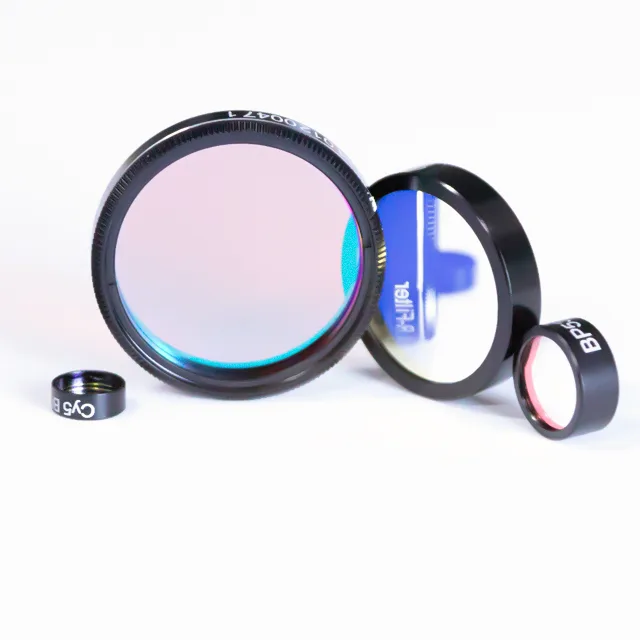
Optolong optical filter can customize what you requirement.
Optical filters are crucial in various industries, from photography and astronomy to telecommunications and medical imaging. They are an essential component of optical systems, helping to enhance image quality, reduce unwanted light, and isolate specific wavelengths.
In this article, we will explore what optical filters are, their types, how to clean them effectively, and answer some frequently asked questions.
What is an Optical Filter, and What Does it Do?
“An optical filter is a device that only transmits or reflects certain wavelengths of light while obstructing others. Optical filters manipulate the properties of light passing through them, such as intensity, color, polarization, or phase.” Manufacturers create filters using various materials, including glass, plastics, or even thin films deposited on surfaces.
Optical filters are commonly used in photography to enhance colors or reduce glare. They are also utilized in scientific instruments to isolate specific wavelengths for precise measurements. Telecommunications companies use optical filters to separate and amplify optical signals, which enables efficient data transmission.
Types of Optical Filters
Absorptive Filters:
These filters absorb specific light wavelengths while transmitting others. They are often made of glass or other materials with dyes or pigments that selectively absorb light. Photographers and cinematographers use absorptive filters to adjust color balance and eliminate unwanted light.
Interference Filters:
Interference filters exploit the principle of interference to transmit specific wavelengths of light selectively. They consist of multiple dielectric layers, reflecting unwanted wavelengths and transmitting the desired ones. Interference filters are widely used in scientific research, astronomy, and telecommunications.
Polarizing Filters:
Polarizing filters are designed to transmit light waves that oscillate in a specific direction while blocking waves vibrating perpendicular to that direction. Photography commonly uses them to reduce reflections from non-metallic surfaces, such as water or glass, and enhance contrast in outdoor scenes.
Neutral Density Filters:
Neutral density filters uniformly reduce light intensity across the visible spectrum. Photography often uses them to achieve longer exposures or wider apertures in bright conditions. Neutral density filters are also utilized in cinematography to control the light reaching the camera sensor.
How to Clean Optical Filters
Cleaning optical filters is essential to maintain their performance and prolong their lifespan. Here is a step-by-step guide to effectively clean optical filters:
- Gather the necessary supplies: You will need a soft, lint-free cloth, a blower brush, lens cleaning solution, and lens tissue.
- Remove loose debris: Use a blower brush to gently remove any loose dust or particles from the surface of the filter. This helps prevent scratching during the cleaning process.
- Apply cleaning solution: Dampen a small section of lens tissue with a few drops of lens cleaning solution. Avoid applying the solution directly to the filter to prevent excessive moisture.
- Wipe the filter: Gently wipe the filter surface in a circular motion with the dampened section of the lens tissue. Start from the center and work your way toward the edges.
- Dry the filter: Use a dry section of the lens tissue or a clean, lint-free cloth to remove any remaining moisture from the filter surface.
- Inspect for smudges: Inspect the filter for any smudges or streaks after cleaning. If necessary, repeat the cleaning process using a fresh lens tissue.
FAQs
Can I stack multiple optical filters together?
Yes, it is possible to stack multiple optical filters together. However, be cautious, as excessive stacking may introduce unwanted vignetting or image quality degradation. It is recommended to experiment and test the combination of filters beforehand.
How often should I clean my optical filters?
Usage and environmental conditions affect how often to clean. As a general guideline, cleaning optical filters when you notice smudges, fingerprints, or visible dirt is advisable. More frequent cleaning may be necessary for filters used in dusty or outdoor conditions.
Can I use regular household cleaning products to clean optical filters?
No, using regular household cleaning products on optical filters is not recommended. These products may contain chemicals that damage the filter coatings or leave a residue. It is best to use specialized lens cleaning solutions designed for optical surfaces.
What should I do if stubborn stains or marks are present on my optical filter?
If stubborn stains or marks persist after the initial cleaning process, it is advisable to consult a professional. They have the expertise and specialized equipment to handle more challenging cleaning situations without causing damage to the filter.
How should I store my optical filters when not in use?
Store your optical filters in a clean and dry environment to protect them when they are not in use. It is recommended to use individual filter cases or pouches to prevent scratches or dust accumulation. Avoid exposing the filters to excessive heat, moisture, or direct sunlight, as these conditions can degrade their performance.
Final Words
Optical filters are essential in various industries, allowing us to manipulate light and achieve desired effects. Understanding the different types of filters enables us to choose the right ones for specific applications. By following the step-by-step cleaning guide, you can maintain the performance of your optical filters and ensure longevity. Remember to use the appropriate cleaning supplies and handle them with care.
